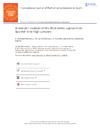Identificador persistente para citar o vincular este elemento:
https://accedacris.ulpgc.es/jspui/handle/10553/106692
| Campo DC | Valor | idioma |
|---|---|---|
| dc.contributor.author | Mateos-Padorno, C. | en_US |
| dc.contributor.author | García Manso, Juan Manuel | en_US |
| dc.contributor.author | Fuentes-García, J.P. | en_US |
| dc.contributor.author | Martínez-Patiño, Mª.J. | en_US |
| dc.date.accessioned | 2021-04-12T07:27:08Z | - |
| dc.date.available | 2021-04-12T07:27:08Z | - |
| dc.date.issued | 2021 | en_US |
| dc.identifier.issn | 2474-8668 | en_US |
| dc.identifier.uri | https://accedacris.ulpgc.es/handle/10553/106692 | - |
| dc.description.abstract | In high jumping, the horizontal velocity which jumpers aim to reach by the end of the run-up must be the maximum that they can control, enabling them to clear the greatest height possible. Furthermore, jumpers should reach the point of take-off with the lowest possible centre of mass (CM) to increase the thrust during take-off and thus produce a greater vertical velocity of the CM at the end of this phase. The aim of this study was to identify gender-related differences in the kinematic parameters of the sprint. The sample comprised 14 high jumpers (n = 8 males and n = 6 females) who were analysed during an official competition and recorded with four high speed panning cameras (sampling frequency: 50 fps). The results showed gender-related differences in the maximum height attained by the centre of mass during the flight phase (p = 0.004; Effect Size = 0.93) and in flight effectiveness (p ≤ 0.001; ES = 5.53), but not in jump effectiveness. Gender-related differences were not detected between the trajectory followed by the CM in the final supports of the run-up and the curve radius or in the direction of the final supports either. In conclusion, there are no significant gender differences in the run-up. | en_US |
| dc.language | eng | en_US |
| dc.relation.ispartof | International Journal Of Performance Analysis In Sport | en_US |
| dc.source | International Journal Of Performance Analysis In Sport [2474-8668], v. 21(3), p. 421-434, (Abril 2021) | en_US |
| dc.subject | 5802 Organización y planificación de la educación | en_US |
| dc.subject.other | Track and field | en_US |
| dc.subject.other | High jump | en_US |
| dc.subject.other | Run-up | en_US |
| dc.subject.other | Kinematical analysis | en_US |
| dc.subject.other | Gender difference | en_US |
| dc.title | Kinematic analysis of the final stride approach in Spanish elite high jumpers | en_US |
| dc.type | info:eu-repo/semantics/article | en_US |
| dc.type | Article | en_US |
| dc.identifier.doi | 10.1080/24748668.2021.1908040 | en_US |
| dc.investigacion | Ciencias Sociales y Jurídicas | en_US |
| dc.type2 | Artículo | en_US |
| dc.utils.revision | Sí | en_US |
| dc.date.coverdate | Abril, 2021 | en_US |
| dc.identifier.ulpgc | Sí | en_US |
| dc.contributor.buulpgc | BU-FIS | en_US |
| dc.description.sjr | 0,708 | |
| dc.description.jcr | 2,488 | |
| dc.description.sjrq | Q2 | |
| dc.description.jcrq | Q3 | |
| dc.description.scie | SCIE | |
| dc.description.miaricds | 8,8 | |
| item.grantfulltext | open | - |
| item.fulltext | Con texto completo | - |
| crisitem.author.dept | GIR Economía de las Infraestructuras, el Transporte y el Turismo | - |
| crisitem.author.dept | Departamento de Educación Física | - |
| crisitem.author.dept | GIR Praxiología motriz, entrenamiento deportivo, didáctica de las actividades físicas y salud | - |
| crisitem.author.orcid | 0000-0003-2406-6031 | - |
| crisitem.author.orcid | 0000-0002-4360-3384 | - |
| crisitem.author.parentorg | Departamento de Análisis Económico Aplicado | - |
| crisitem.author.parentorg | Departamento de Educación Física | - |
| crisitem.author.fullName | Mateos Padorno, Covadonga | - |
| crisitem.author.fullName | García Manso, Juan Manuel | - |
| Colección: | Artículos | |
Visitas
161
actualizado el 28-dic-2024
Descargas
669
actualizado el 28-dic-2024
Google ScholarTM
Verifica
Altmetric
Comparte
Exporta metadatos
Los elementos en ULPGC accedaCRIS están protegidos por derechos de autor con todos los derechos reservados, a menos que se indique lo contrario.
